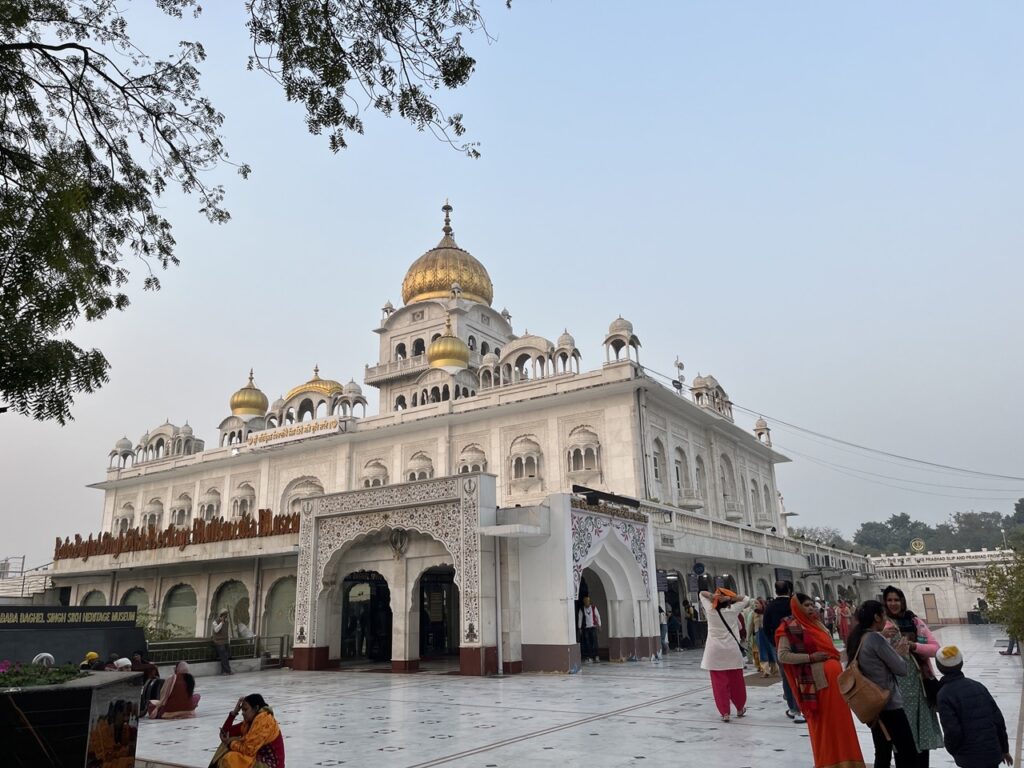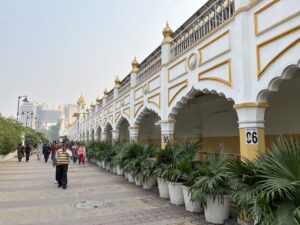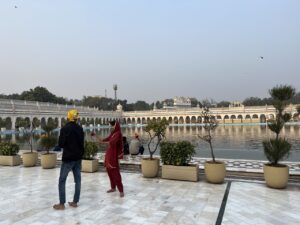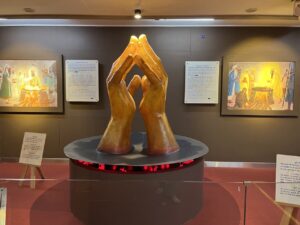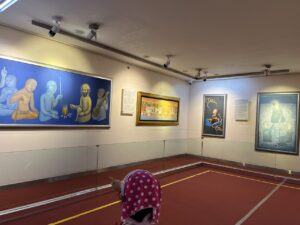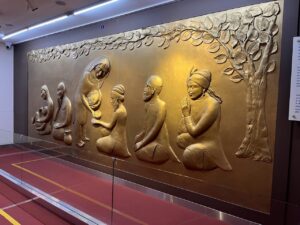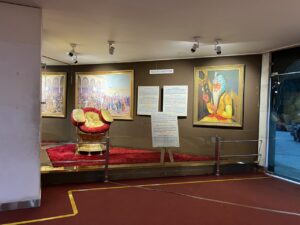We’ve seen a show on National Geographic a few years ago called “India’s Mega Kitchens”. The show introduces massive kitchens throughout India, many of them in gurudwara’s (Sikh temples), that produce insane amounts of food. The kitchens are enormous industrial facilities that are manned almost entirely by volunteers. They prepare strictly vegetarian food and the largest kitchens produce enough to feed upwards of a staggering one hundred thousand people a day.
We were curious about the massive kitchen but weren’t actually prepared to partake in the langar (the communal meal), so before heading to the gurudwara, we stopped by a restaurant nearby the temple, Sandoz, for a late lunch. After filling up on delicious curries and naan, we hopped on another rickshaw and headed to the temple.
Gurudwara Bangla Sahib is the largest Sikh temple in Delhi. Its history starts in the 17th century during the Mughal reign of Emperor Aurangzeb, known to be a ruthless tyrant who imposed strict Sharia law and persecuted non-Muslims. He instituted discriminatory policies against Hindus and ordered the executions of non-Muslim religious leaders.
In 1664, Sikh Guru Har Krishan, the eighth of 10 gurus, was summoned to Delhi by Emperor Aurangzeb. When Sikh Guru Har Krishan arrived in Delhi, he was warmly welcomed to the magnificent haveli of Mirza Raja Jai Singh, a Rajput (Hindu) king of the Kingdom of Amber (now Jaipur) and a top general of Aurangzeb. When he arrived, Jai Singh put the guru to a number of tests to prove that he was indeed a true guru. The guru performed feats only a true guru would be capable of.
Sikhs from far and wide visited the guru at the haveli, chanting songs and bringing offerings. During his stay at the haveli, he performed miracles of healing, curing the sick of cholera and smallpox with water from the well at the haveli. He was known to be wise and humble as he preached the teachings of Sikhism which earned him many new followers. After some time, Sikh Guru Har Krishan contracted smallpox and passed away. The haveli was eventually converted into a Gurudwara by the Sikh general Sardar Baghel Singh and named Bangla Sahib. The well, whose waters were used by Guru Har Krishan to cure the sick, was turned into a pond (sarovar) and its waters are considered by Sikhs to be sacred.
Sikh temples welcome everybody. Equality is a central tenet of their faith. The only requirement upon entering is that everybody is respectively dressed and both men and women must cover their hair. We covered our hair with scarves and neck gators, but we saw that there were free head coverings that could be borrowed upon entering the gurudwara.
Once inside the grounds, everybody must remove their shoes and store them in a central storage area that is staffed completely by volunteers. Another central tenet of Sikhism is to serve others. Members of the Sikh community can volunteer in the gurudwara by working in the shoe room, cooking in the langar, cleaning the grounds and many other jobs. We were impressed with the organization and cleanliness of the shoe room. There were even volunteers cleaning the shoes before handing them back to the visitors
We walked past different buildings in the complex, not sure what they were used for. We walked by the langar but it seemed to be closed. The langar closes for an early evening break in between the late-lunch service and the dinner service. We followed the crowd into the main hall of the temple. There was a religious service in progress with several men chanting around a golden domed structure under which was a platform holding the Guru Granth Sahib (the Sikh holy book) that was covered by a golden silk cloth. There were several musicians sitting at the side playing religious music.
We joined the sitting area, a comfortable carpeted area, for visitors and worshippers where men, women, families and children, young and old, were watching the religious proceedings. Some had their eyes closed in concentration but most were like us, looking and watching. After some time had passed, we decided to continue through the hall. This led us to the Sarovar, the sacred pool at the center of the gurudwara. This massive pool is fed by the well water that Sikh Guru Har Krishan used to cure the sick who had contracted cholera and small pox. Some worshipers descended the steps into the pool and splashed the holy water onto their faces and heads. We saw a mother undress her child down to his underwear. He walked down the steps into the holy water and then submerged half of his body into the water. I wondered if the child was sick or hurt. I could only feel grateful that we were just there just to learn and to witness, not in search of a cure.
We walked around the sarovar and circled back to the front of the complex. We entered the visitor’s center and were greeted by a tall Sikh man wearing a turban. He smiled to us and gestured us inside. The visitor’s center was a wealth of information to teach us about the Sikh faith.
I realized that many Indian Americans that I grew up around in Fremont are Sikhs. Many Sikhs use the surname “Singh” which is an elected surname to show that they are all part of one big family. While men adopt the surname “Singh” (lion), women adopt the surname “Kaur” (crowned princess). Sikhs can also be identified by the five K’s:
– Kesh (uncut hair covered by a turban)
– Kara (steel bracelet)
– Kanga (small wooden comb)
– Kacchera (undershorts worn as an undergarment)
– Kirpan (small curved dagger)
Sikhism is the 5th largest religion in the world, with 25 million followers. It is an inclusive monotheistic religion founded by Guru Nanak in the 15th century in Punjab. Sikhs believe in the oneness of all people as expressed through equality.
The three core pillars of Sikhism are:
– Service: sharing and helping others
– Honest living: earning an honest living and speaking the truth at all times
– Decency and humility
Sikhs don’t believe that any one religion has a monopoly on religious truth. They are required by their religion to defend the rights of any and all religions as vehemently as they would defend their own. There were many paintings in the visitors center that depicted the ultimate sacrifice and martyrdom of Sikh gurus. The ninth Sikh guru, Guru Tegh Bahadur was tortured and executed by Mughal Emperor Aurangzeb when he refused to convert to Islam. He gave his life in the name of freedom of religion and worship.
This is the first time that I have heard of a major religion embracing other religions in such a fundamental and explicit way. Juxtaposed beside the other major monotheistic religions of the world, Sikhism seems refreshingly inclusive and humane.
Author
-

Song is the mother of four children. She and her family have stepped away from it all and in September 2023, began traveling the world while homeschooling. Song is an ABC (American born Chinese) and has an undergraduate degree from Cornell and an MBA from Harvard. She is an entrepreneur and an educator. Her hobbies include learning, traveling, reading, cooking and baking, and being with children.

